Selection of Landing Sites for the Chang’E-7 Mission Using Multi-Source Remote Sensing Data
Abstract
1. Introduction
- 1.
- All potential safe landing sites within the southern polar region (≥85°S) for the CE-7 lander, characterized by flat topography and adequate illumination, are proposed. The accessibility of these sites to cold traps is further evaluated. Flying routes between each landing site (lander) in the illuminated region and sampling site (mini-flying probe) in the cold trap are also investigated;
- 2.
- For these reasonable landing sites, high-resolution illumination conditions (i.e., average illumination, longest duration of daylight, and darkness) are analyzed;
- 3.
- A combination of optical and radar images is employed to identify small-scale hazards within the landing and sampling sites that are not resolvable on topography data. Finally, six potential landing sites and corresponding sampling sites for CE-7 are proposed.
2. Backgrounds
2.1. Geological and Environmental Context of the Lunar South Pole
2.2. The Mission Concept of Chang’E-7
- 1.
- Landing site for the lander: The landing site must be flat, positioned away from steep small crater walls, and free of boulders to ensure landing safety. It should provide sufficient illumination to support energy requirements for the eight-year mission. Most critically, a viable flight path must exist between the landing and sampling sites;
- 2.
- Sampling site for the mini-flying probe: The sampling site should have a high probability of bearing water ice and must be flat and free of rocks.
3. Materials and Methods
3.1. Determination of the Mini-Flying Probe Sampling Regions
3.1.1. Likelihood of Bearing Water Ice
3.1.2. Landing Safety of the Mini-Flying Probe
3.2. Preselection of Potential Landing Regions for the Lander
3.2.1. Generation of Safe Landing Cells
3.2.2. Search and Evaluation of Flight Routes
3.2.3. Aggregation of Landing Cells into Regions and Their Evaluation
3.3. Characterization of Selected Landing Regions and Identification of Optimal Landing Sites
3.3.1. High-Resolution Illumination Condition Analysis
3.3.2. Identification of Small-Scale Hazards: Small Craters
3.3.3. Identification of Small-Scale Hazards: Rocky Region
4. Results
4.1. Cold Traps Prioritized for the CE-7 Mission
4.2. Landing Regions for Selected Cold Traps
4.2.1. Potential Landing Regions
4.2.2. Statistical Analysis of Potential Landing Regions
4.2.3. Selection of Optimal Landing Regions
4.3. Detailed Characterization of Selected Landing Regions
4.3.1. High-Resolution Illumination Variation
4.3.2. Distribution of Small Shadow-Casting Craters
4.3.3. Distribution of Rocky Region
4.3.4. Optimal Landing Site Within the Selected Landing Regions
5. Discussion
5.1. Proposed Landing Sites for the CE-7 Mission
5.2. Implications for the CE-7 Mission
6. Conclusions
Supplementary Materials
Author Contributions
Funding
Data Availability Statement
Acknowledgments
Conflicts of Interest
References
- Heiken, G.H.; Vaniman, D.T.; French, B.M. Lunar Sourcebook, a User’s Guide to the Moon; Cambridge University Press: Cambridge, UK, 1991. [Google Scholar]
- Watson, K.; Murray, B.; Brown, H. On the possible presence of ice on the Moon. J. Geophys. Res. (1896–1977) 1961, 66, 1598–1600. [Google Scholar] [CrossRef]
- Lawrence, D.J. A tale of two poles: Toward understanding the presence, distribution, and origin of volatiles at the polar regions of the Moon and Mercury. J. Geophys. Res. Planets 2017, 122, 21–52. [Google Scholar] [CrossRef]
- Zhang, Y.; Zhao, F.; Chang, S.; Liu, M.; Wang, R. An Innovative Synthetic Aperture Radar Design Method for Lunar Water Ice Exploration. Remote Sens. 2022, 14, 2148. [Google Scholar] [CrossRef]
- Arnold, J.R. Ice in the lunar polar regions. J. Geophys. Res. Solid Earth 1979, 84, 5659–5668. [Google Scholar] [CrossRef]
- Campbell, D.B.; Campbell, B.A.; Carter, L.M.; Margot, J.L.; Stacy, N.J.S. No evidence for thick deposits of ice at the lunar south pole. Nature 2006, 443, 835–837. [Google Scholar] [CrossRef]
- Fisher, E.A.; Lucey, P.G.; Lemelin, M.; Greenhagen, B.T.; Siegler, M.A.; Mazarico, E.; Aharonson, O.; Williams, J.P.; Hayne, P.O.; Neumann, G.A.; et al. Evidence for surface water ice in the lunar polar regions using reflectance measurements from the Lunar Orbiter Laser Altimeter and temperature measurements from the Diviner Lunar Radiometer Experiment. Icarus 2017, 292, 74–85. [Google Scholar] [CrossRef]
- Hayne, P.O.; Hendrix, A.; Sefton-Nash, E.; Siegler, M.A.; Lucey, P.G.; Retherford, K.D.; Williams, J.P.; Greenhagen, B.T.; Paige, D.A. Evidence for exposed water ice in the Moon’s south polar regions from Lunar Reconnaissance Orbiter ultraviolet albedo and temperature measurements. Icarus 2015, 255, 58–69. [Google Scholar] [CrossRef]
- Li, S.; Lucey, P.G.; Milliken, R.E.; Hayne, P.O.; Fisher, E.; Williams, J.P.; Hurley, D.M.; Elphic, R.C. Direct evidence of surface exposed water ice in the lunar polar regions. Proc. Natl. Acad. Sci. USA 2018, 115, 8907. [Google Scholar] [CrossRef]
- Sanin, A.B.; Mitrofanov, I.G.; Litvak, M.L.; Malakhov, A.; Boynton, W.V.; Chin, G.; Droege, G.; Evans, L.G.; Garvin, J.; Golovin, D.V.; et al. Testing lunar permanently shadowed regions for water ice: LEND results from LRO. J. Geophys. Res. Planets 2012, 117, E00H26. [Google Scholar] [CrossRef]
- Sathyan, S.; Bhatt, M.; Chowdhury, M.; Gläser, P.; Misra, D.; Srivastava, N.; Narendranath, S.; Sajinkumar, K.S.; Bhardwaj, A. Potential landing sites characterization on lunar south pole: De-Gerlache to Shackleton ridge region. Icarus 2024, 412, 115988. [Google Scholar] [CrossRef]
- Spudis, P.D.; Bussey, D.B.J.; Baloga, S.M.; Cahill, J.T.S.; Glaze, L.S.; Patterson, G.W.; Raney, R.K.; Thompson, T.W.; Thomson, B.J.; Ustinov, E.A. Evidence for water ice on the Moon: Results for anomalous polar craters from the LRO Mini-RF imaging radar. J. Geophys. Res. Planets 2013, 118, 2016–2029. [Google Scholar] [CrossRef]
- Stacy, N.J.S.; Campbell, D.B.; Ford, P.G. Arecibo Radar Mapping of the Lunar Poles: A Search for Ice Deposits. Science 1997, 276, 1527–1530. [Google Scholar] [CrossRef]
- Eke, V.R.; Bartram, S.A.; Lane, D.A.; Smith, D.; Teodoro, L.F.A. Lunar polar craters—Icy, rough or just sloping? Icarus 2014, 241, 66–78. [Google Scholar] [CrossRef][Green Version]
- Beyer, R.A.; Colaprete, A.; Shirley, M.; Balaban, E.; Siegler, M.; Camacho-Martinez, J. VIPER Site Selection. In Proceedings of the 53rd Lunar and Planetary Science Conference, Houston, TX, USA, 7–11 March 2022; p. 2479. [Google Scholar]
- Bhattacharya, S.; Dagar, A.K.; Pathak, S.; Rajasekhar, R.P.; Naik, S.S.; Kiran Kumar, A.S.; Desai, N.M.; Gupta, S.; Panigrahi, M.K. Characterization of ISRO-JAXA LUPEX Landing Site Near Shackleton-De Gerlache Ridge (SDR) Region Based on Observations from Chandrayaan-2 Imaging InfraRed Spectrometer (IIRS) Instrument. In Proceedings of the 54th Lunar and Planetary Science Conference, Houston, TX, USA, 13–17 March 2023; p. 2098. [Google Scholar]
- Wang, C.; Jia, Y.; Xue, C.; Lin, Y.; Liu, J.; Fu, X.; Xu, L.; Huang, Y.; Zhao, Y.; Xu, Y.; et al. Scientific objectives and payload configuration of the Chang’E-7 mission. Natl. Sci. Rev. 2023, 11, nwad329. [Google Scholar] [CrossRef]
- De Rosa, D.; Bussey, B.; Cahill, J.T.; Lutz, T.; Crawford, I.A.; Hackwill, T.; van Gasselt, S.; Neukum, G.; Witte, L.; McGovern, A.; et al. Characterisation of potential landing sites for the European Space Agency’s Lunar Lander project. Planet. Space Sci. 2012, 74, 224–246. [Google Scholar] [CrossRef]
- Heather, D.J.; Fisackerly, R.K.; Trautner, R.; Barber, S.; Houdou, B.; Boazman, S.; Team, P.S.; Consortium, P.I. The ESA PROSPECT Payload for CP22: Science Activities and Operations Planning. In Proceedings of the 55th Lunar and Planetary Science Conference, Houston, TX, USA, 11–15 March 2024; p. 1085. [Google Scholar]
- Hu, T.; Yang, Z.; Li, M.; van der Bogert, C.H.; Kang, Z.; Xu, X.; Hiesinger, H. Possible sites for a Chinese International Lunar Research Station in the Lunar South Polar Region. Planet. Space Sci. 2023, 227, 105623. [Google Scholar] [CrossRef]
- Huang, Q.; Liu, S.; Yang, X.; Tong, X. Artemis III pre-selected landing sites engineering suitability analysis with illumination, communication and slope, based on LOLA terrain. In Proceedings of the International Conference on Remote Sensing, Mapping, and Geographic Systems (RSMG 2023), Kaifeng, China, 7–9 July 2023; SPIE: Bellingham, WA, USA, 2023; Volume 12815. [Google Scholar]
- Kumari, N.; Bretzfelder, J.M.; Ganesh, I.; Lang, A.; Kring, D.A. Surface Conditions and Resource Accessibility at Potential Artemis Landing Sites 007 and 011. Planet. Sci. J. 2022, 3, 224. [Google Scholar] [CrossRef]
- CNSA. Chang’E-7 Mission Payload Opportunity Announcement. Available online: https://www.cnsa.gov.cn/n6758823/n6758838/c6840869/content.html (accessed on 9 September 2024). (In Chinese)
- Beyer, R.A.; Alexandrov, O.; Balaban, E.; Colaprete, A.; Shirley, M.; Martinez-Camacho, J.; Siegler, M. VIPER Geospatial Data for Site Selection and Traverse Planning. In Proceedings of the 54th Lunar and Planetary Science Conference, Houston, TX, USA, 13–17 March 2023; p. 2377. [Google Scholar]
- Blewett, D.T.; Meyer, H.M.; Kinczyk, M.J.; Halekas, J.; Ho, G.C.; Greenhagen, B.T.; Denevi, B.W.; Klima, R.L.; Cahill, J.T.S.; Anderson, B.J.; et al. Selection and Characterization of the Landing Site for NASA CLPS PRISM1 Lunar Lander Mission CP-11. In Proceedings of the 54th Lunar and Planetary Science Conference, Houston, TX, USA, 13–17 March 2023; p. 1780. [Google Scholar]
- Boazman, S.J.; Heather, D.; Inoue, H.; Ohtake, M. Mapping Potential Hazards and Identifying Sampling Points within Lunar South Polar Region Areas of Interest. Planet. Sci. J. 2024, 5, 279. [Google Scholar] [CrossRef]
- Boazman, S.J.; Shah, J.; Harish; Gawronska, A.J.; Halim, S.H.; Satyakumar, A.V.; Gilmour, C.M.; Bickel, V.T.; Barrett, N.; Kring, D.A. The Distribution and Accessibility of Geologic Targets near the Lunar South Pole and Candidate Artemis Landing Sites. Planet. Sci. J. 2022, 3, 275. [Google Scholar] [CrossRef]
- Cannon, K.M.; Britt, D.T. Accessibility Data Set for Large Permanent Cold Traps at the Lunar Poles. Earth Space Sci. 2020, 7, e2020EA001291. [Google Scholar] [CrossRef]
- Cao, Y.; Wang, Y.; Liu, J.; Zeng, X.; Wang, J. Selection of Whole-Moon Landing Zones Based on Weights of Evidence and Fractals. Remote Sens. 2022, 14, 4623. [Google Scholar] [CrossRef]
- Feng, Y.; Li, H.; Tong, X.; Li, P.; Wang, R.; Chen, S.; Xi, M.; Sun, J.; Wang, Y.; He, H.; et al. Optimized Landing Site Selection at the Lunar South Pole: A Convolutional Neural Network Approach. IEEE J. Sel. Top. Appl. Earth Obs. Remote Sens. 2024, 17, 10998–11015. [Google Scholar] [CrossRef]
- Ivanov, M.A.; Hiesinger, H.; Abdrakhimov, A.M.; Basilevsky, A.T.; Head, J.W.; Pasckert, J.H.; Bauch, K.; van der Bogert, C.H.; Gläser, P.; Kohanov, A. Landing site selection for Luna-Glob mission in crater Boguslawsky. Planet. Space Sci. 2015, 117, 45–63. [Google Scholar] [CrossRef]
- Jia, Y.; Liu, L.; Wang, X.; Guo, N.; Wan, G. Selection of Lunar South Pole Landing Site Based on Constructing and Analyzing Fuzzy Cognitive Maps. Remote Sens. 2022, 14, 4863. [Google Scholar] [CrossRef]
- Jia, Y.; Zhang, S.; Liu, B.; Di, K.; Xie, B.; Nan, J.; Zhao, C.; Wan, G. A robust method for large-scale route optimization on lunar surface utilizing a multi-level map model. Chin. J. Aeronaut. 2025, 38, 103388. [Google Scholar] [CrossRef]
- Lemelin, M.; Blair, D.M.; Roberts, C.E.; Runyon, K.D.; Nowka, D.; Kring, D.A. High-priority lunar landing sites for in situ and sample return studies of polar volatiles. Planet. Space Sci. 2014, 101, 149–161. [Google Scholar] [CrossRef]
- Liu, D.; Gan, H.; Wei, G.; Qiu, Y.; Wan, L.; Li, X. Lunar South Polar Landing Area Selection Constrained by Illumination Conditions and Slopes. J. Deep. Space Explor. 2023, 10, 544–556. [Google Scholar] [CrossRef]
- Liu, H.; Wang, Y.; Wen, S.; Liu, J.; Wang, J.; Cao, Y.; Meng, Z.; Zhang, Y. A New Blind Selection Approach for Lunar Landing Zones Based on Engineering Constraints Using Sliding Window. Remote Sens. 2023, 15, 3184. [Google Scholar] [CrossRef]
- Liu, J.; Zeng, X.; Li, C.; Ren, X.; Yan, W.; Tan, X.; Zhang, X.; Chen, W.; Zuo, W.; Liu, Y.; et al. Landing Site Selection and Overview of China’s Lunar Landing Missions. Space Sci. Rev. 2020, 217, 6. [Google Scholar] [CrossRef]
- Liu, N.; Jin, Y.Q. Selection of a Landing Site in the Permanently Shadowed Portion of Lunar Polar Regions Using DEM and Mini-RF Data. IEEE Geosci. Remote. Sens. Lett. 2022, 19, 4503305. [Google Scholar] [CrossRef]
- Peña Asensio, E.; Neira-Acosta, A.S.; Sánchez-Lozano, J.M. Evaluating potential landing sites for the Artemis III mission using a multi-criteria decision making approach. arXiv 2024, arXiv:2406.19863. [Google Scholar]
- Rao, W.; Fang, Y.; Peng, S.; Zhang, H.; Sheng, L.; Ma, J. Landing Site Selection Method of Lunar South Pole Region. J. Deep. Space Explor. 2022, 9, 571–578. [Google Scholar] [CrossRef]
- Tomka, R.; Boazman, S.; Bradák, B.; Heather, D.J.; Kereszturi, A.; Pal, B.D.; Steinmann, V. Boulder distribution, circular polarization, and optical maturity: A survey of example lunar polar terrains for future landing sites. Adv. Space Res. 2024, 73, 2243–2260. [Google Scholar] [CrossRef]
- Wen, S.; Wang, Y.; Gong, Q.; Liu, J.; Kang, X.; Liu, H.; Chen, R.; Zhu, K.; Zhang, S. A New Robust Lunar Landing Selection Method Using the Bayesian Optimization of Extreme Gradient Boosting Model (BO-XGBoost). Remote Sens. 2024, 16, 3632. [Google Scholar] [CrossRef]
- Zhang, H.; Du, Y.; Li, F.; Zhang, H.; Ma, J.; Sheng, L.; Wu, K. Proposals for Sites Selection of Soft Landing on Lunar South Polar Region. J. Deep. Space Explor. 2020, 7, 232–240. [Google Scholar] [CrossRef]
- Butler, N.; Lee, P. Comparison and Rating of Candidate Artemis 3 Landing Regions on the Basis of South Pole-Aitken Basin Material Sampling and Exposed H2O Ice Investigation. In Proceedings of the 55th Lunar and Planetary Science Conference, Houston, TX, USA, 11–15 March 2024; p. 1403. [Google Scholar]
- Liu, N.; Jin, Y.Q. A Statistical Rule of the Stokes Parameters of Pol-SAR for Identifying Flat Surface in PSR. IEEE Geosci. Remote Sens. Lett. 2023, 20, 4002705. [Google Scholar] [CrossRef]
- Amitabh, S.; Srinivasan, T.P.; Suresh, K. Potential Landing Sites for Chandrayaan-2 Lander in Southern Hemisphere of Moon. In Proceedings of the 49th Lunar and Planetary Science Conference, Houston, TX, USA, 19–23 March 2018; p. 1975. [Google Scholar]
- Bernhardt, H.; Robinson, M.S.; Boyd, A.K. Geomorphic map and science target identification on the Shackleton-de Gerlache ridge. Icarus 2022, 379, 114963. [Google Scholar] [CrossRef]
- Kawashima, O.; Morota, T.; Ohtake, M.; Kasahara, S. Size-frequency measurements of meter-sized craters and boulders in the lunar polar regions for landing-site selections of future lunar polar missions. Icarus 2022, 378, 114938. [Google Scholar] [CrossRef]
- Wei, G.; Li, X.; Zhang, W.; Tian, Y.; Jiang, S.; Wang, C.; Ma, J. Illumination conditions near the Moon’s south pole: Implication for a concept design of China’s Chang’E-7 lunar polar exploration. Acta Astronaut. 2023, 208, 74–81. [Google Scholar] [CrossRef]
- Zhong, Z.; Yan, J.; He, H.; Wen, Q.; Liu, D.; Barriot, J.P. Illumination and regolith temperature at China’s next candidate lunar landing site Shackleton crater. Sci. China Earth Sci. 2023, 66, 417–429. [Google Scholar] [CrossRef]
- Yu, H.; Rao, W.; Zhang, Y.; Xing, Z. Mission Analysis and Spacecraft Design of Chang’E-7. J. Deep. Space Explor. 2023, 10, 567–576. [Google Scholar] [CrossRef]
- Garrick-Bethell, I.; Zuber, M.T. Elliptical structure of the lunar South Pole-Aitken basin. Icarus 2009, 204, 399–408. [Google Scholar] [CrossRef]
- Krasilnikov, S.S.; Ivanov, M.A.; Head, J.W.; Krasilnikov, A.S. Geologic history of the south circumpolar region (SCR) of the Moon. Icarus 2023, 394, 115422. [Google Scholar] [CrossRef]
- Hiesinger, H.; van der Bogert, C.H.; Pasckert, J.H.; Schmedemann, N.; Robinson, M.S.; Jolliff, B.; Petro, N. New Crater Size-Frequency Distribution Measurements of the South Pole-Aitken Basin. In Proceedings of the 43rd Lunar and Planetary Science Conference, Houston, TX, USA, 19–23 March 2012; p. 2863. [Google Scholar]
- Joy, K.H.; Wang, N.; Snape, J.F.; Goodwin, A.; Pernet-Fisher, J.F.; Whitehouse, M.J.; Liu, Y.; Lin, Y.T.; Darling, J.R.; Tar, P.; et al. Evidence of a 4.33 billion year age for the Moon’s South Pole-Aitken basin. Nat. Astron. 2024, 9, 55–65. [Google Scholar] [CrossRef] [PubMed]
- Citron, R.I.; Smith, D.E.; Stewart, S.T.; Hood, L.L.; Zuber, M.T. The South Pole-Aitken Basin: Constraints on Impact Excavation, Melt, and Ejecta. Geophys. Res. Lett. 2024, 51, e2024GL110034. [Google Scholar] [CrossRef]
- Krasilnikov, A.S.; Ivanov, M.A.; Krasilnikov, S.S.; Head, J.W. Stratigraphic cross-sections, geologic history, and provenance of material at the candidate landing sites of the Artemis missions. Icarus 2024, 420, 116190. [Google Scholar] [CrossRef]
- Cannon, K.M.; Britt, D.T. A geologic model for lunar ice deposits at mining scales. Icarus 2020, 347, 113778. [Google Scholar] [CrossRef]
- Deutsch, A.N.; Head, J.W.; Neumann, G.A. Analyzing the ages of south polar craters on the Moon: Implications for the sources and evolution of surface water ice. Icarus 2020, 336, 113455. [Google Scholar] [CrossRef]
- Mazarico, E.; Neumann, G.A.; Smith, D.E.; Zuber, M.T.; Torrence, M.H. Illumination conditions of the lunar polar regions using LOLA topography. Icarus 2011, 211, 1066–1081. [Google Scholar] [CrossRef]
- Gläser, P.; Scholten, F.; De Rosa, D.; Marco Figuera, R.; Oberst, J.; Mazarico, E.; Neumann, G.A.; Robinson, M.S. Illumination conditions at the lunar south pole using high resolution Digital Terrain Models from LOLA. Icarus 2014, 243, 78–90. [Google Scholar] [CrossRef]
- Schörghofer, N.; Rufu, R. Past extent of lunar permanently shadowed areas. Sci. Adv. 2023, 9, eadh4302. [Google Scholar] [CrossRef] [PubMed]
- Speyerer, E.J.; Robinson, M.S.; Boyd, A.; Wagner, R.V.; Henriksen, M.R. Exploration of the Lunar South Pole with LROC Data Products. In Proceedings of the Lunar Surface Science Workshop, Virtual, 28–30 April 2020; Volume 2241, p. 5132. [Google Scholar]
- Yin, Z.; Liu, N.; Jin, Y.Q. Simulation of the Temperatures in Permanently Shadowed Region of the Crater Shackleton and Implications to In-situ Detection. IEEE J. Sel. Top. Appl. Earth Obs. Remote Sens. 2024, 17, 6739–6746. [Google Scholar] [CrossRef]
- Yin, Z.; Liu, N.; Jin, Y.Q. Simulation of the temperatures in the permanently shadowed region of the Moon’s south pole and data validation. Icarus 2024, 411, 115917. [Google Scholar] [CrossRef]
- Paige, D.A.; Siegler, M.A.; Zhang, J.A.; Hayne, P.O.; Foote, E.J.; Bennett, K.A.; Vasavada, A.R.; Greenhagen, B.T.; Schofield, J.T.; McCleese, D.J.; et al. Diviner Lunar Radiometer Observations of Cold Traps in the Moon’s South Polar Region. Science 2010, 330, 479–482. [Google Scholar] [CrossRef]
- Xu, L.; Zou, Y.L.; Qin, L. Overview of China’s Lunar Exploration Program and Scientific Vision for Future Missions. In Proceedings of the 50th Lunar and Planetary Science Conference, Houston, TX, USA, 18–22 March 2019; p. 2440. [Google Scholar]
- Li, X.; Wang, X.; Lu, W.; Guo, M.; Huang, Z.; Zhang, X.; Xu, Z.; Yao, L.; Ruan, J.; Kan, R.; et al. Design for In-Situ Water Ice Analysis in the Lunar Polar Region. J. Deep. Space Explor. 2023, 10, 618–630. [Google Scholar] [CrossRef]
- Mahanti, P.; Thompson, T.J.; Robinson, M.S.; Humm, D.C. View Factor-Based Computation of Secondary Illumination Within Lunar Permanently Shadowed Regions. IEEE Geosci. Remote Sens. Lett. 2022, 19, 8027004. [Google Scholar] [CrossRef]
- Schorghofer, N.; Williams, J.P. Mapping of Ice Storage Processes on the Moon with Time-dependent Temperatures. Planet. Sci. J. 2020, 1, 54. [Google Scholar] [CrossRef]
- Nozette, S.; Lichtenberg, C.L.; Spudis, P.; Bonner, R.; Ort, W.; Malaret, E.; Robinson, M.; Shoemaker, E.M. The Clementine Bistatic Radar Experiment. Science 1996, 274, 1495–1498. [Google Scholar] [CrossRef]
- Spudis, P.D.; Bussey, D.B.J.; Baloga, S.M.; Butler, B.J.; Carl, D.; Carter, L.M.; Chakraborty, M.; Elphic, R.C.; Gillis-Davis, J.J.; Goswami, J.N.; et al. Initial results for the north pole of the Moon from Mini-SAR, Chandrayaan-1 mission. Geophys. Res. Lett. 2010, 37, L06204. [Google Scholar] [CrossRef]
- Lawrence, D.J.; Peplowski, P.N.; Wilson, J.T.; Elphic, R.C. Global Hydrogen Abundances on the Lunar Surface. J. Geophys. Res. Planets 2022, 127, e2022JE007197. [Google Scholar] [CrossRef]
- Sanin, A.B.; Mitrofanov, I.G.; Litvak, M.L.; Bakhtin, B.N.; Bodnarik, J.G.; Boynton, W.V.; Chin, G.; Evans, L.G.; Harshman, K.; Fedosov, F.; et al. Hydrogen distribution in the lunar polar regions. Icarus 2017, 283, 20–30. [Google Scholar] [CrossRef]
- Campbell, B.A. High circular polarization ratios in radar scattering from geologic targets. J. Geophys. Res. Planets 2012, 117, E06008. [Google Scholar] [CrossRef]
- Fa, W.; Eke, V.R. Unravelling the Mystery of Lunar Anomalous Craters Using Radar and Infrared Observations. J. Geophys. Res. Planets 2018, 123, 2119–2137. [Google Scholar] [CrossRef]
- Litvak, M.L.; Mitrofanov, I.G.; Sanin, A.B.; Golovin, D.V.; Malakhov, A.V.; Boynton, W.V.; Droege, G.F.; Harshman, K.; Starr, R.D.; Milikh, G.; et al. LEND neutron data processing for the mapping of the Moon. J. Geophys. Res. Planets 2012, 117, E00H32. [Google Scholar] [CrossRef]
- Mitrofanov, I.G.; Sanin, A.B.; Boynton, W.V.; Chin, G.; Garvin, J.B.; Golovin, D.; Evans, L.G.; Harshman, K.; Kozyrev, A.S.; Litvak, M.L.; et al. Hydrogen Mapping of the Lunar South Pole Using the LRO Neutron Detector Experiment LEND. Science 2010, 330, 483–486. [Google Scholar] [CrossRef]
- Mitrofanov, I.; Litvak, M.; Sanin, A.; Malakhov, A.; Golovin, D.; Boynton, W.; Droege, G.; Chin, G.; Evans, L.; Harshman, K.; et al. Testing polar spots of water-rich permafrost on the Moon: LEND observations onboard LRO. J. Geophys. Res. Planets 2012, 117, E00H27. [Google Scholar] [CrossRef]
- Boynton, W.V.; Droege, G.F.; Mitrofanov, I.G.; McClanahan, T.P.; Sanin, A.B.; Litvak, M.L.; Schaffner, M.; Chin, G.; Evans, L.G.; Garvin, J.B.; et al. High spatial resolution studies of epithermal neutron emission from the lunar poles: Constraints on hydrogen mobility. J. Geophys. Res. Planets 2012, 117, E00H33. [Google Scholar] [CrossRef]
- Robinson, M.S.; Brylow, S.M.; Caplinger, M.A.; Carter, L.M.; Clark, M.J.; Denevi, B.W.; Estes, N.M.; Humm, D.C.; Mahanti, P.; Peckham, D.A.; et al. ShadowCam Instrument and Investigation Overview. J. Astron. Space Sci. 2023, 40, 149–171. [Google Scholar] [CrossRef]
- Cahill, J.T.S.; Thomson, B.J.; Patterson, G.W.; Bussey, D.B.J.; Neish, C.D.; Lopez, N.R.; Turner, F.S.; Aldridge, T.; McAdam, M.; Meyer, H.M.; et al. The Miniature Radio Frequency instrument’s (Mini-RF) global observations of Earth’s Moon. Icarus 2014, 243, 173–190. [Google Scholar] [CrossRef]
- Barker, M.K.; Mazarico, E.; Neumann, G.A.; Smith, D.E.; Zuber, M.T.; Head, J.W. Improved LOLA elevation maps for south pole landing sites: Error estimates and their impact on illumination conditions. Planet. Space Sci. 2021, 203, 105119. [Google Scholar] [CrossRef]
- Horn, B.K.P. Hill shading and the reflectance map. Proc. IEEE 1981, 69, 14–47. [Google Scholar] [CrossRef]
- Flahaut, J.; Carpenter, J.; Williams, J.P.; Anand, M.; Crawford, I.A.; van Westrenen, W.; Füri, E.; Xiao, L.; Zhao, S. Regions of interest (ROI) for future exploration missions to the lunar South Pole. Planet. Space Sci. 2020, 180, 104750. [Google Scholar] [CrossRef]
- Zhang, A.; Lipton, Z.C.; Li, M.; Smola, A.J. Dive into Deep Learning; Cambridge University Press: Cambridge, UK, 2023. [Google Scholar]
- Pérez Sanz, L.; Fernández-Shaw González, A.; Pérez-Castán, J.A.; Serrano-Mira, L.; Rodríguez Fernández, D.; Sánchez Ayra, E. Additional Clearance over Obstacles to Determine Minimum Flight Altitude in Mountainous Terrain. Appl. Sci. 2024, 14, 5155. [Google Scholar] [CrossRef]
- Williams, J.; Boggs, D.; Folkner, W. DE421 Lunar Orbit, Physical Librations, and Surface Coordinates, JPL IOM 335-JW, DB; Technical Report. WF-20080314-001; JPL: Pasadena, CA, USA, 2008. [Google Scholar]
- Rhodes, B. Skyfield: High Precision Research-Grade Positions for Planets and Earth Satellites Generator; Version ascl:1907.024; Astrophysics Source Code Library: Houghton, MI, USA, 2019. [Google Scholar]
- Archinal, B.A.; Weller, L.A.; Richie, J.O.; Lee, E.M.; Bennett, K.A.; Speyerer, E.J.; Tyburczy, T. Controlled High-Resolution LROC NAC Polar Mosaics. In Proceedings of the 54th Lunar and Planetary Science Conference, Houston, TX, USA, 13–17 March 2023; p. 2333. [Google Scholar]
- Zhao, F.; Gao, Y.; Dang, Y.; Lu, P.; Meng, T.; Yang, T.; Wang, R. Refining Constraints on the Origin of Lunar Irregular Mare Patches via Mini-RF and DFSAR Data Analysis. IEEE J. Sel. Top. Appl. Earth Obs. Remote Sens. 2024, 17, 8213–8229. [Google Scholar] [CrossRef]
- Xu, Z.; Zhao, F.; Lu, P.; Gao, Y.; Meng, T.; Dang, Y.; Li, M. Automatic Registration of Mini-Rf S-Band Level-1 Data. In Proceedings of the IGARSS 2024—2024 IEEE International Geoscience and Remote Sensing Symposium, Athens, Greece, 7–12 July 2024; pp. 6142–6145. [Google Scholar] [CrossRef]
- Gao, Y.; Zhao, F.; Hou, W.; Han, Y.; Liu, M.; Dang, Y.; Lu, P.; Wang, R. Analysis of Rock Abundance on Lunar Surface and Near-Surface Using Mini-RF SAR Data. IEEE J. Sel. Top. Appl. Earth Obs. Remote Sens. 2023, 16, 9590–9605. [Google Scholar] [CrossRef]
- Raney, R.K.; Cahill, J.T.S.; Patterson, G.W.; Bussey, D.B.J. The m-chi decomposition of hybrid dual-polarimetric radar data with application to lunar craters. J. Geophys. Res. Planets 2012, 117, E00H21. [Google Scholar] [CrossRef]
- Gonzales, R.C.; Wintz, P. Digital Image Processing; Addison-Wesley Longman Publishing Co., Inc.: Boston, MA, USA, 1987. [Google Scholar]
- Colaprete, A.; Schultz, P.; Heldmann, J.; Wooden, D.; Shirley, M.; Ennico, K.; Hermalyn, B.; Marshall, W.; Ricco, A.; Elphic, R.C.; et al. Detection of Water in the LCROSS Ejecta Plume. Science 2010, 330, 463–468. [Google Scholar] [CrossRef]
- Yang, C.; Wang, X.; Zhao, D.; Guan, R.; Zhao, H. Accurate Mapping and Evaluation of Small Impact Craters within the Lunar Landing Area. Remote Sens. 2024, 16, 2165. [Google Scholar] [CrossRef]
- Su, Y.; Xu, L. Chang’e-6 Nearby Craters Within a 1 km Diameter and the Simulated Craters; Zenodo: Geneva, Switzerland, 2024. [Google Scholar] [CrossRef]
- Michael, G.G. Planetary Surface Dating with Craterstats3—A New Open Source Implementation in Python. In Proceedings of the 2021 Annual Meeting of Planetary Geologic Mappers, Virtually, 28 June–2 July 2021; Volume 2610, p. 7010. [Google Scholar]
- Lloyd, V.; Johnson, A.; Hambleton, K. NASA Identifies Candidate Regions for Landing Next Americans on Moon. Available online: https://www.nasa.gov/news-release/nasa-identifies-candidate-regions-for-landing-next-americans-on-moon/ (accessed on 27 January 2025).
- Taveau, J. NASA Provides Update on Artemis III Moon Landing Regions. Available online: https://www.nasa.gov/news-release/nasa-provides-update-on-artemis-iii-moon-landing-regions/ (accessed on 27 January 2025).
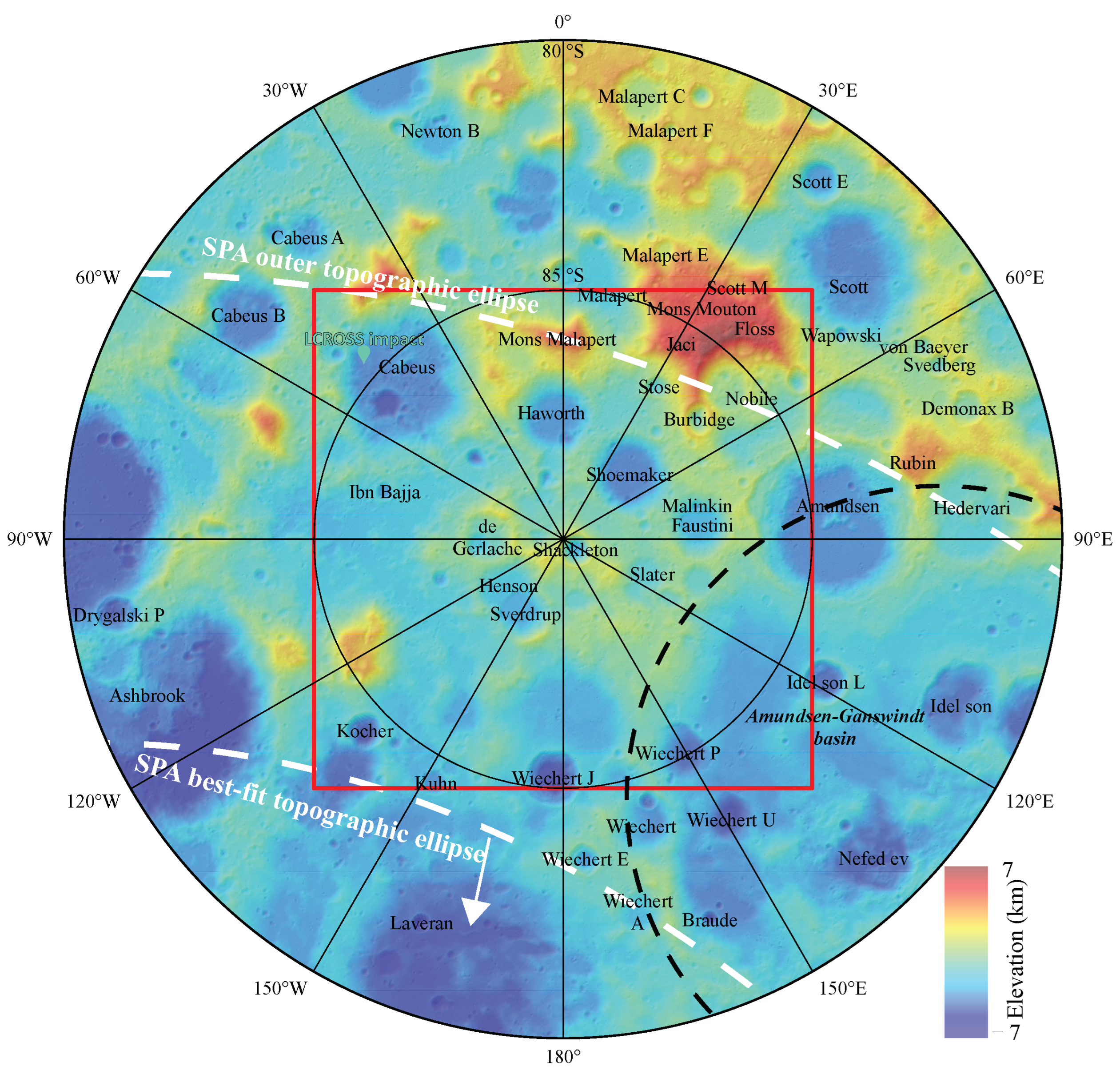

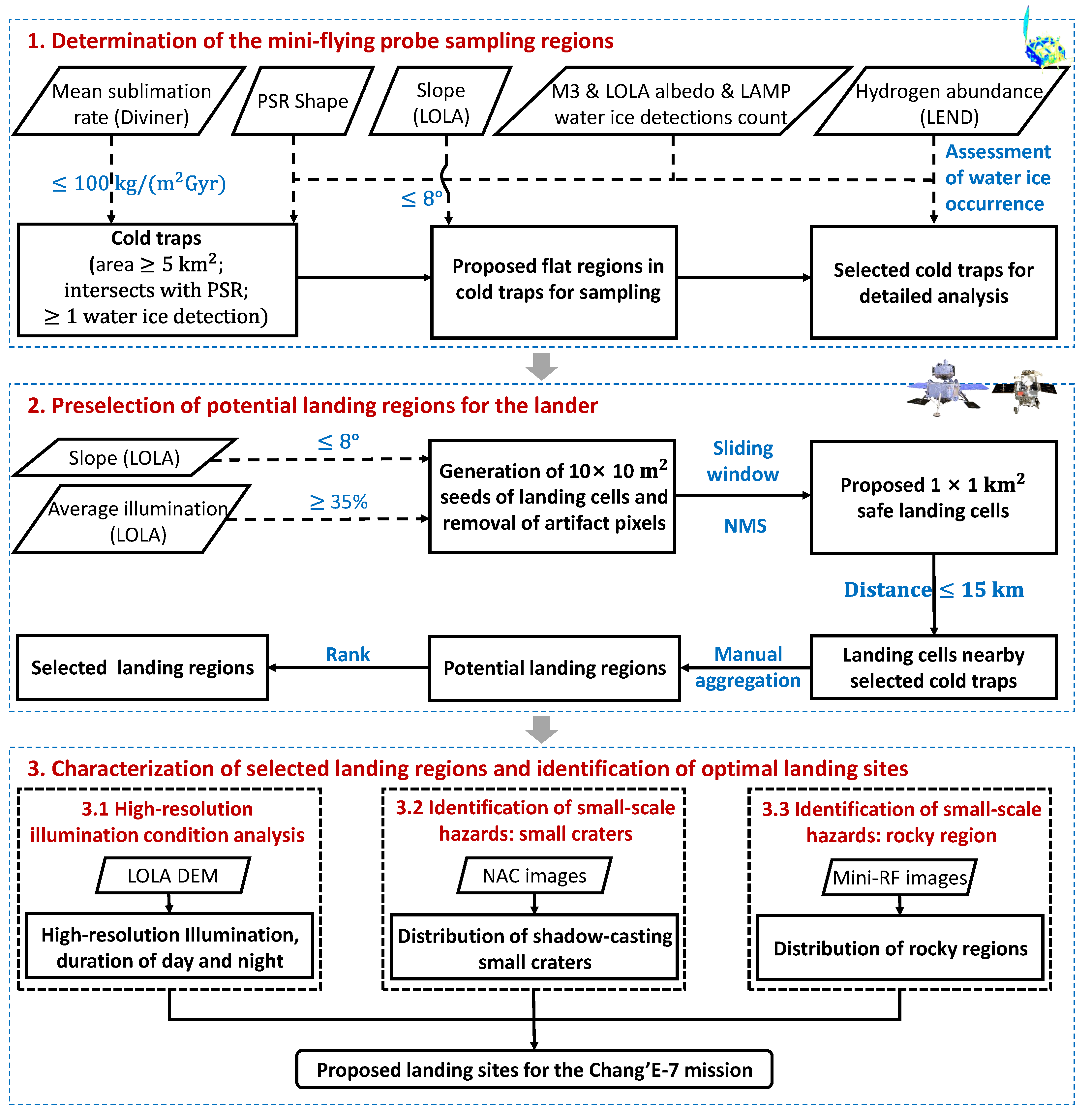

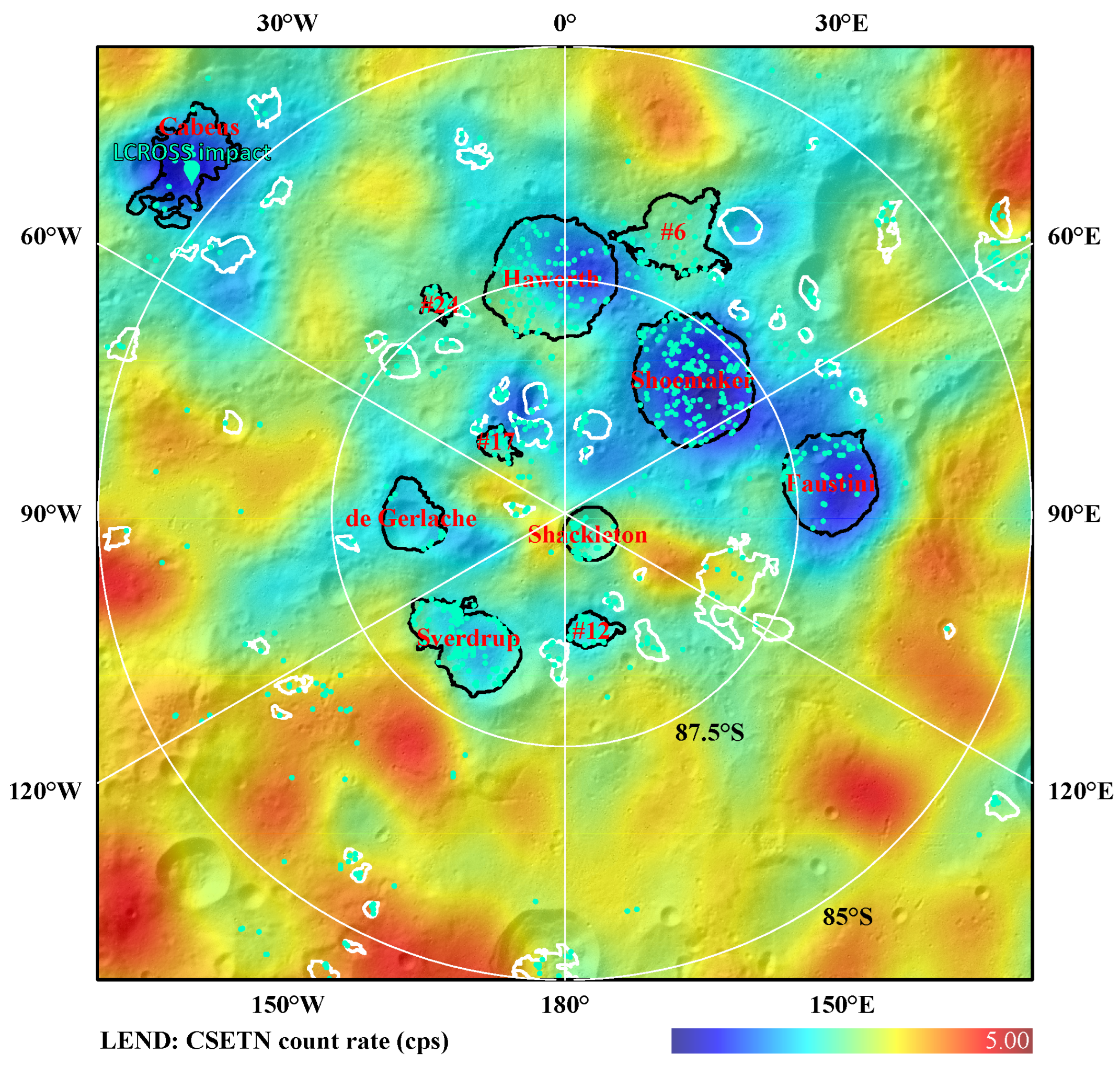
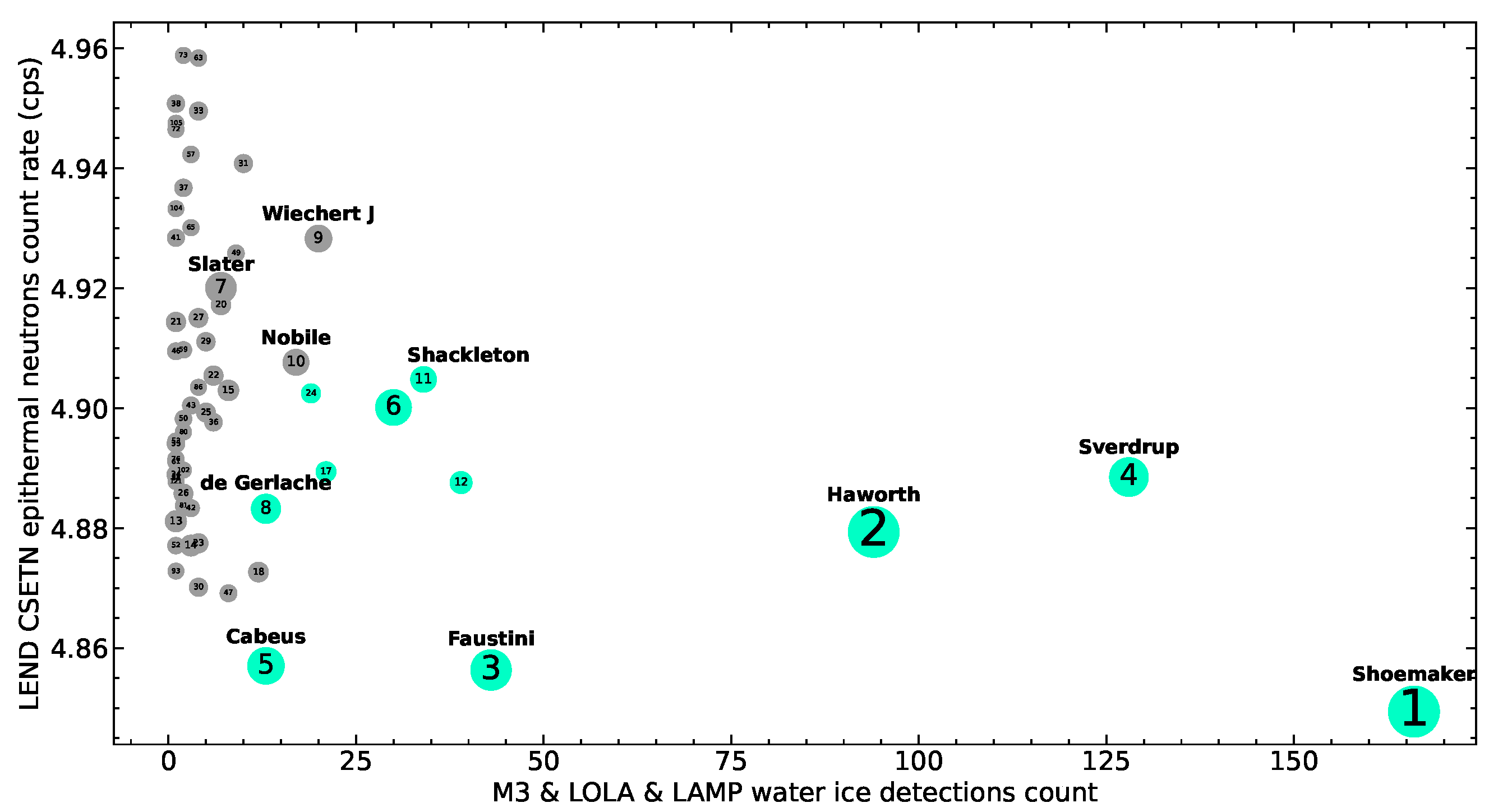
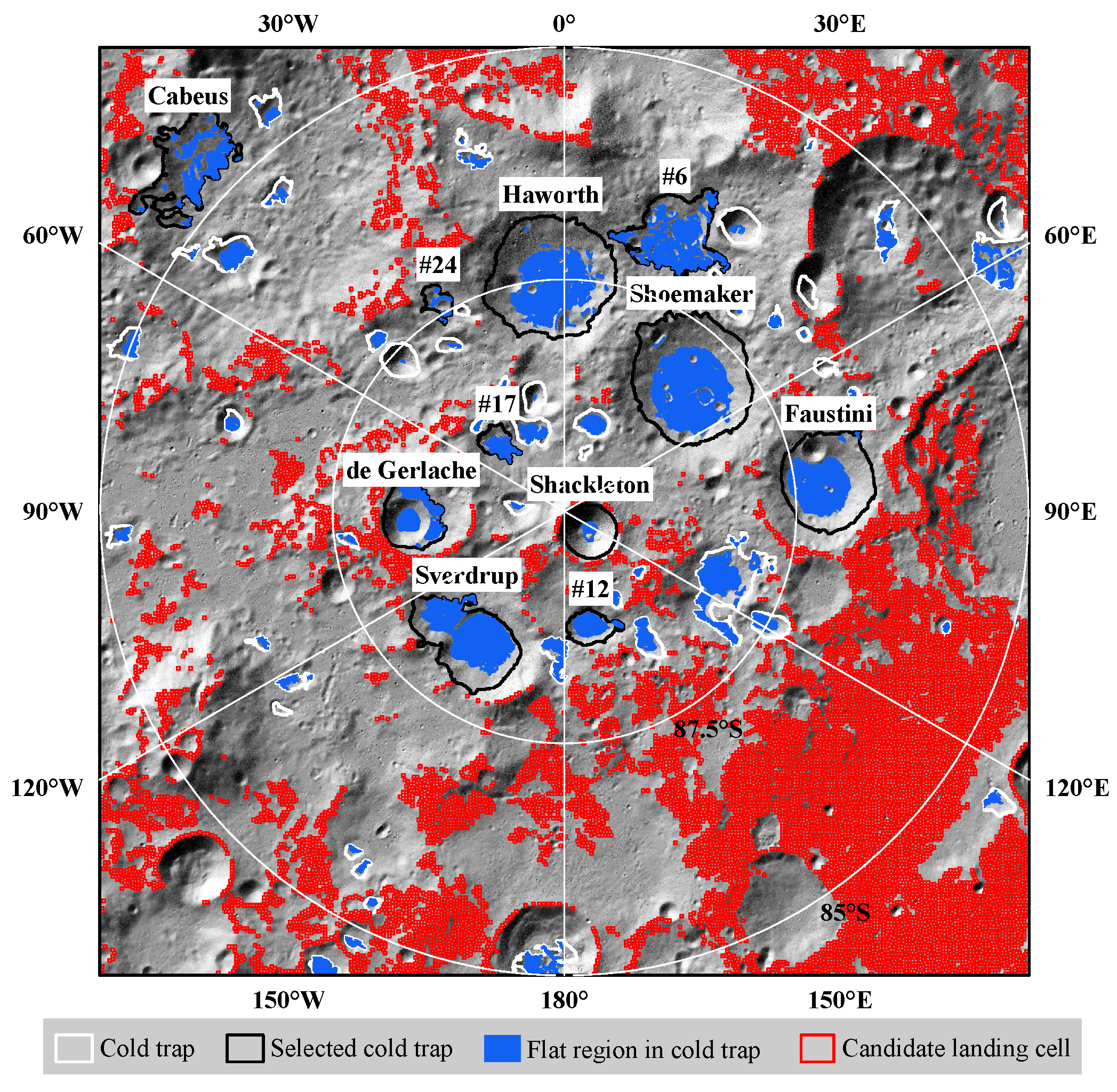
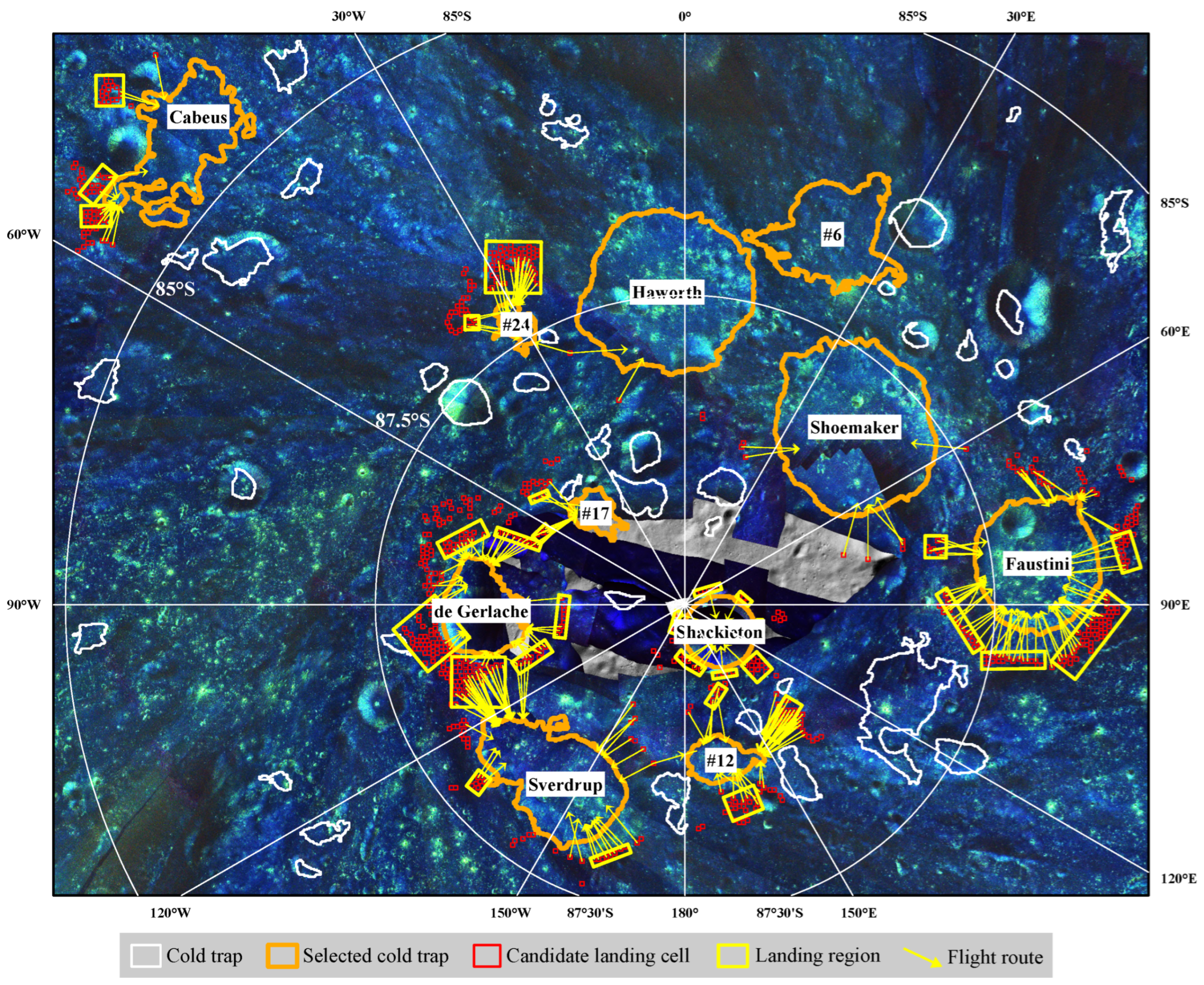
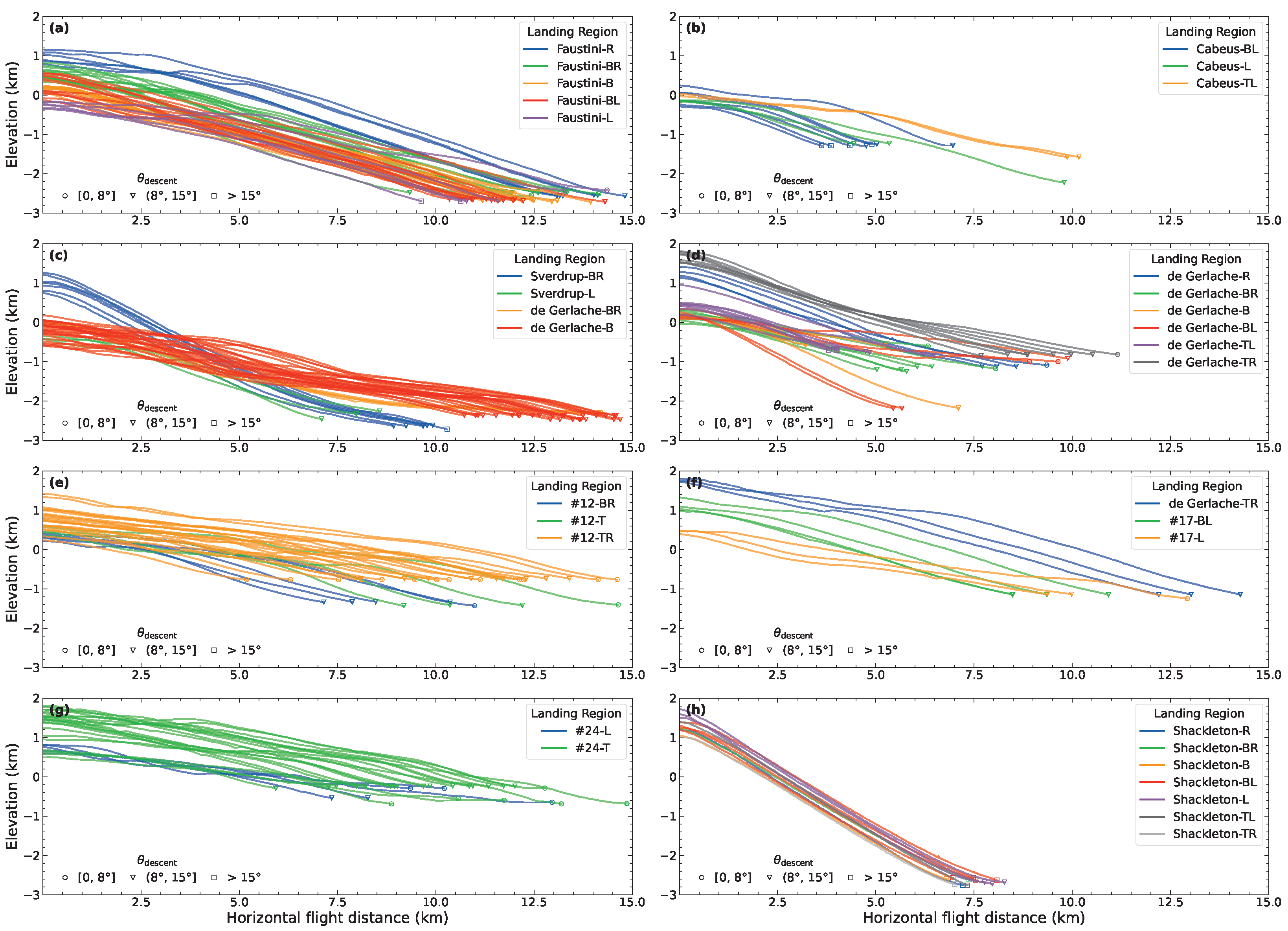
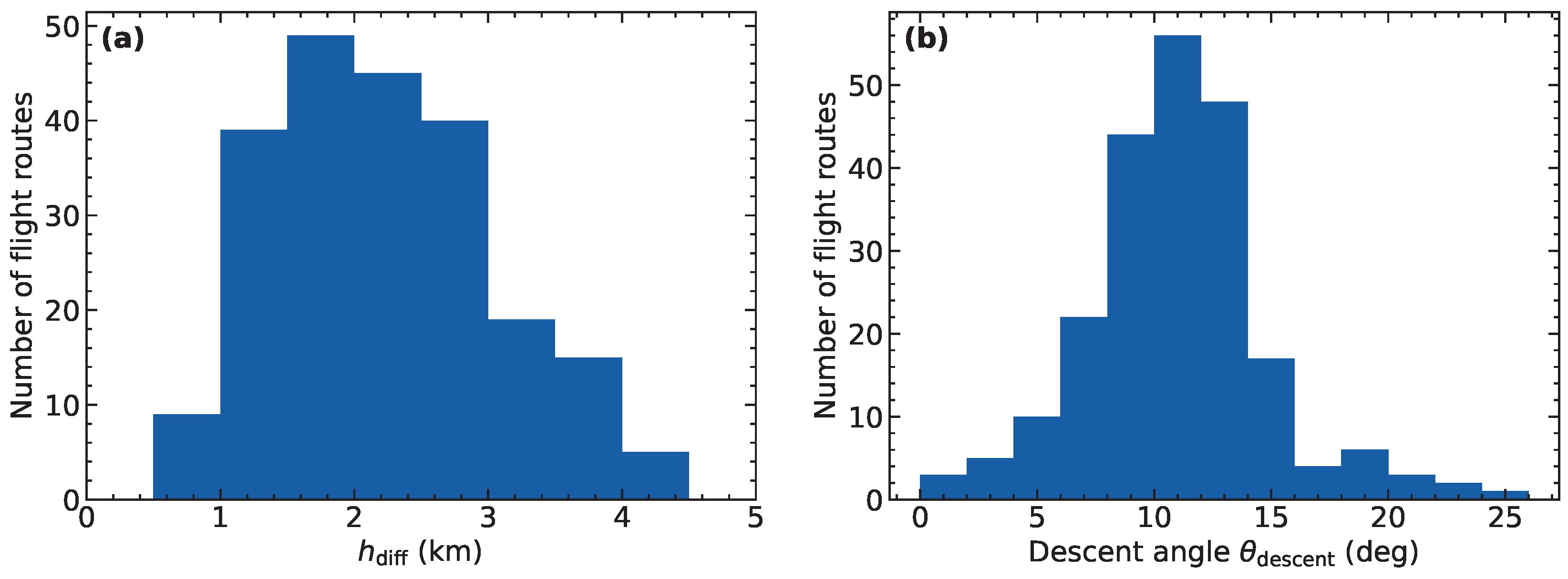
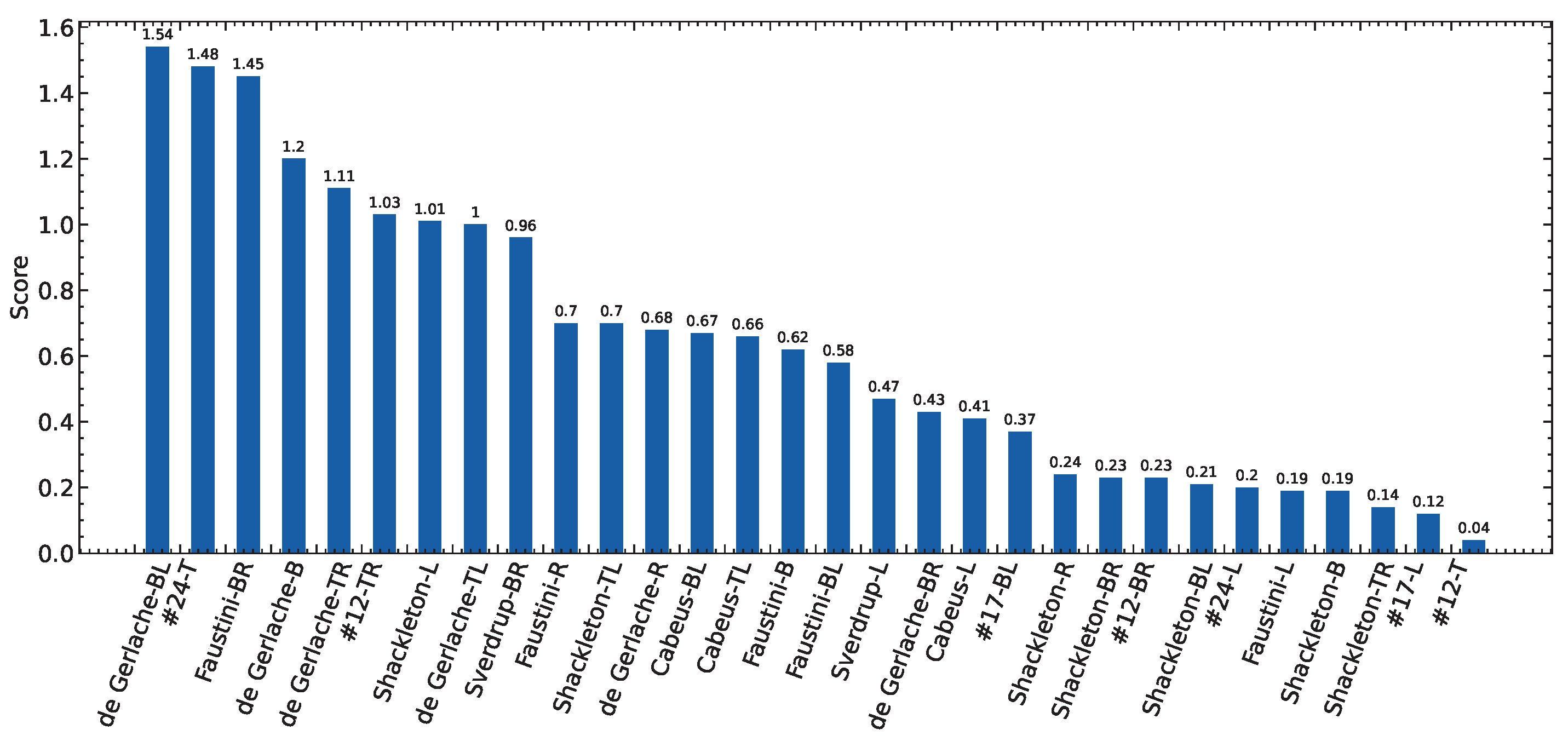


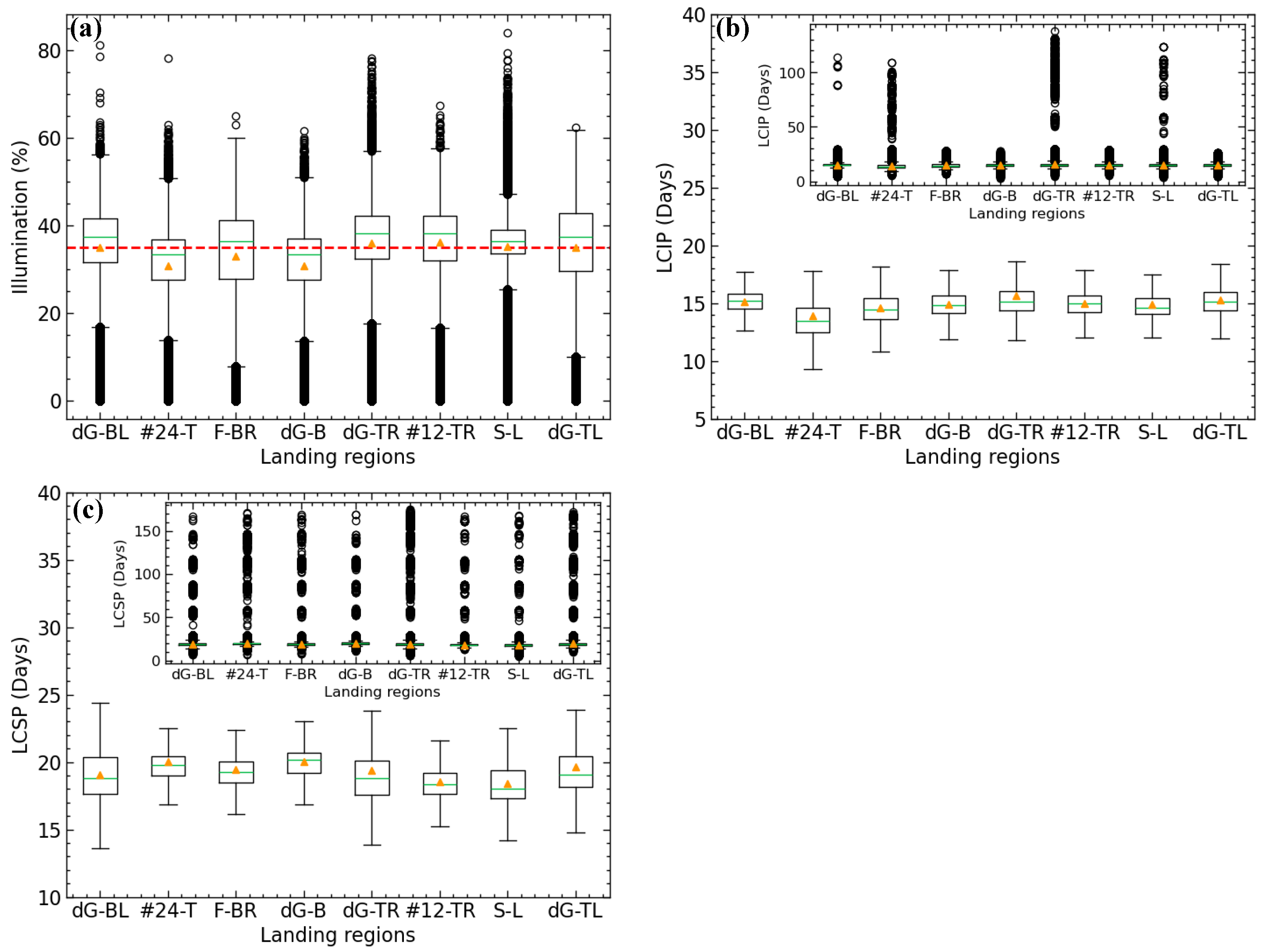

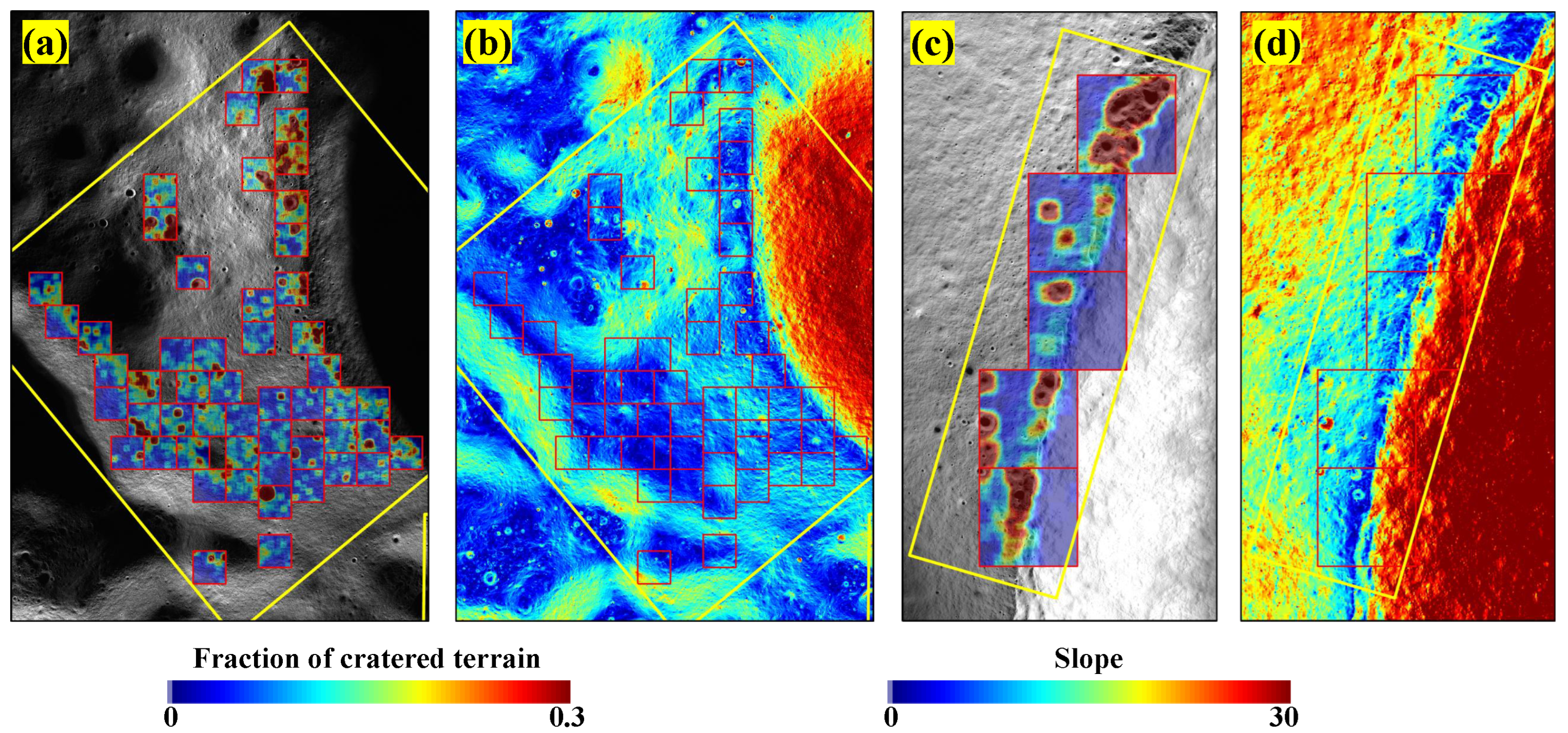





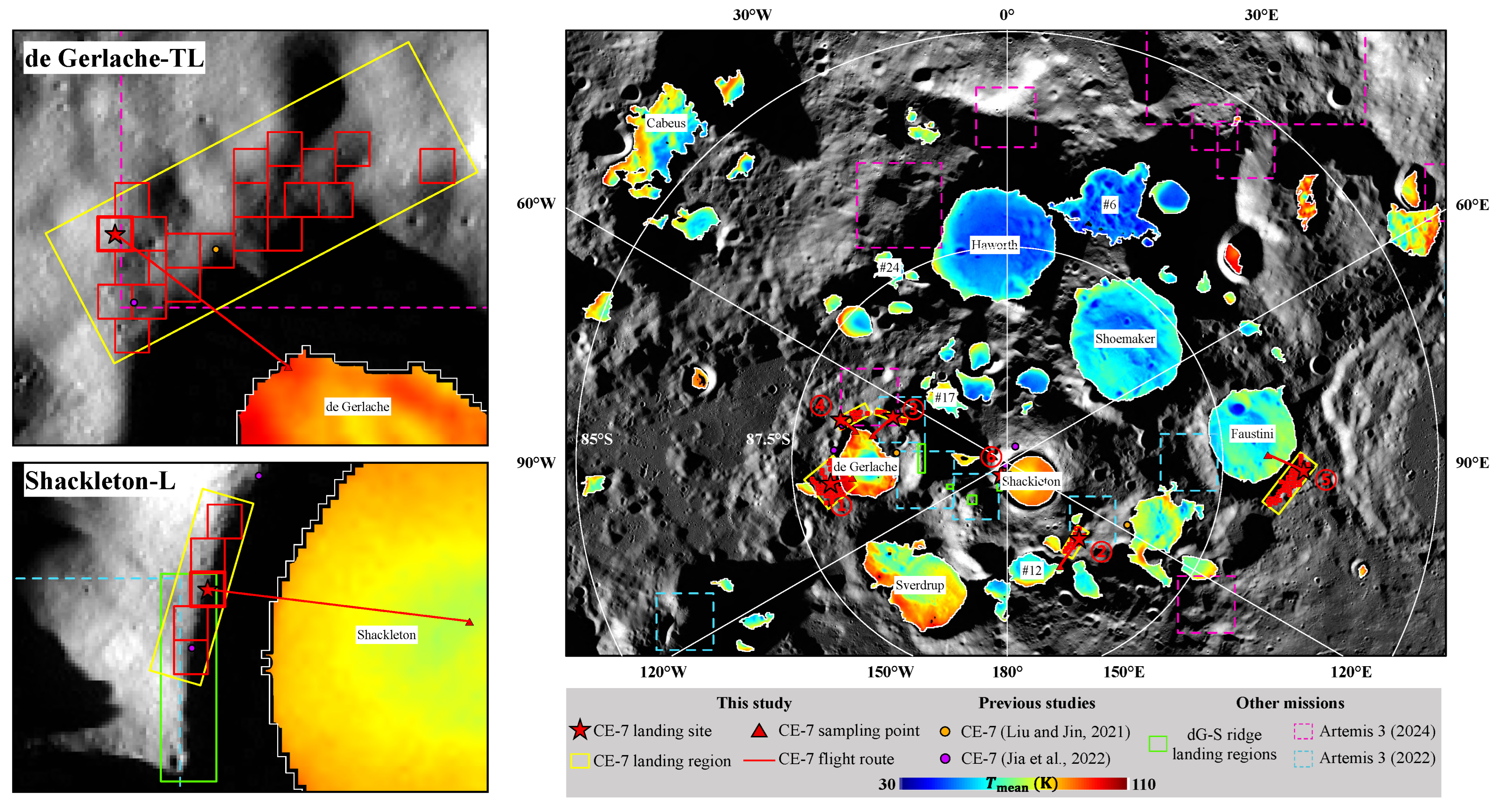

| Landing Site | Lon. (°) | Lat. (°) | Med. Slope (°) | Avg. Illum. (%) | Cratered Fraction (%) | Rocky Fraction (%) | Topography Along Flight Path | Remarks | ||
|---|---|---|---|---|---|---|---|---|---|---|
| (km) | (km) | (m) | ||||||||
| de Gerlache-BL | −96.714 | −87.935 | 8.2 | 44.7 | 9.0 | 1.3 | 8.0 | 2.5 | −314 | Pros: Highest average illumination; Located within an extensive well-illuminated region. Cons: Requires 300 m vertical climb for the mini-flying probe. |
| #12-TR | 136.648 | −88.784 | 8.9 | 42.5 | 12.5 | 0.3 | 11.7 | 1.6 | 0 | Pros: Provides access to multiple cold traps. Cons: Contains many hazardous small craters. |
| de Gerlache-TR | −68.066 | −88.572 | 11.6 | 41.4 | 11.3 | 0.0 | 9.5 | 2.5 | 0 | Pros: Contains points with illumination ≥ 60%; Provides access to multiple cold traps. Cons: Presence of several small craters with very poor illumination. |
| de Gerlache-TL | −75.496 | −88.001 | 12.3 | 42.9 | 5.8 | 6.2 | 6.4 | 0.8 | −384 | Pros: Few areas with very low illumination; Shortest flight distance. Cons: Requires 400 m vertical climb for the mini-flying probe. |
| Faustini-BR | 91.548 | −86.560 | 9.6 | 42.1 | 5.1 | 0.1 | 13.9 | 3.0 | −192 | Pros: Located within an extensive well-illuminated region; Targeted cold trap most likely contains water ice. Cons: Requires 200 m vertical climb for the mini-flying probe; Longest flight distance. |
| Shackleton-L | −153.223 | −89.840 | 14.8 | 36.4 | 10.5 | 0.6 | 7.8 | 4.3 | 0 | Pros: Contains points with illumination ≥ 60%. Cons: Extensive areas with poor illumination; Safe landing zones are limited due to small craters and steep topography. |
Disclaimer/Publisher’s Note: The statements, opinions and data contained in all publications are solely those of the individual author(s) and contributor(s) and not of MDPI and/or the editor(s). MDPI and/or the editor(s) disclaim responsibility for any injury to people or property resulting from any ideas, methods, instructions or products referred to in the content. |
© 2025 by the authors. Licensee MDPI, Basel, Switzerland. This article is an open access article distributed under the terms and conditions of the Creative Commons Attribution (CC BY) license (https://creativecommons.org/licenses/by/4.0/).
Share and Cite
Zhao, F.; Lu, P.; Meng, T.; Dang, Y.; Gao, Y.; Xu, Z.; Wang, R.; Wu, Y. Selection of Landing Sites for the Chang’E-7 Mission Using Multi-Source Remote Sensing Data. Remote Sens. 2025, 17, 1121. https://doi.org/10.3390/rs17071121
Zhao F, Lu P, Meng T, Dang Y, Gao Y, Xu Z, Wang R, Wu Y. Selection of Landing Sites for the Chang’E-7 Mission Using Multi-Source Remote Sensing Data. Remote Sensing. 2025; 17(7):1121. https://doi.org/10.3390/rs17071121
Chicago/Turabian StyleZhao, Fei, Pingping Lu, Tingyu Meng, Yanan Dang, Yao Gao, Zihan Xu, Robert Wang, and Yirong Wu. 2025. "Selection of Landing Sites for the Chang’E-7 Mission Using Multi-Source Remote Sensing Data" Remote Sensing 17, no. 7: 1121. https://doi.org/10.3390/rs17071121
APA StyleZhao, F., Lu, P., Meng, T., Dang, Y., Gao, Y., Xu, Z., Wang, R., & Wu, Y. (2025). Selection of Landing Sites for the Chang’E-7 Mission Using Multi-Source Remote Sensing Data. Remote Sensing, 17(7), 1121. https://doi.org/10.3390/rs17071121








